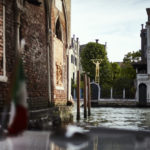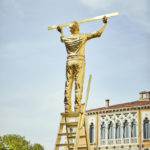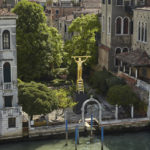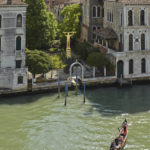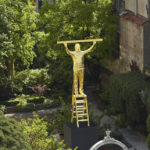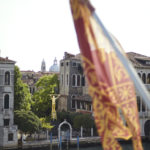curated by Joanna De Vos
silicon bronze and gold leaf
ca. 9m high, including plinth
unique piece
On the occasion of the 58th International Art Exhibition of the Venice Biennale, the great artist Jan Fabre returns to the lagoon with a special project of public art, a unique open-air installation. Installed in the Garden of Palazzo Balbi Valier and visible from the Grand Canal, The Man Who Measures the Clouds (Monument to the Measure of the Immeasurable) appears as a towering golden man rising to a height of nine metres.
The project stems from the collaboration of Angelos (Antwerp, BE), EdM Productions and the Fondation Linda et Guy Pieters (Saint-Tropez, FR) and is curated by Joanna De Vos. It will be unveiled to the public at 5 pm on Monday 6 May and remain in place until the end of the 2019 Art Biennale, on Sunday 24 November.
It is over the tenth time that Jan Fabre contributes as an active part in the great Venetian jamboree, where he first participated in 1984 at the age of twenty-six, as Belgium’s representative in the Giardini. Since then, Fabre has been present both as one of the officially selected artists and in relation to collateral events.
The Man Who Measures the Clouds (Monument to the Measure of the Immeasurable) is a new and unique monumental work finished in gold leaf. It’s especially conceived for Venice, making a deep connection with this city stretching back decades. Protruding above the arch leading into the Garden of Palazzo Balbi Valier from the Grand Canal, this towering golden man reflects not only the drift of the artist and mankind, but also the historic significance and values of this mythical floating city.
The sculpture’s title refers to the story of the legendary Birdman of Alcatraz, Robert Stroud, who at the time of his release from prison had declared that from that moment on he was ‘going to measure the clouds’, and is an invitation for us to reflect on the artist’s role in society. The work can be interpreted as a “metaphor for the artist who tries to capture the impossible in his work”, to quote Fabre’s own words, and might take its inspiration from the philosopher Protagoras’ assertion: ‘Man is the measure of all things: of the things that are, that they are, of the things that are not, that they are not.’ For the Greeks, man was the unit of measurement of the mutual relationship between objects and, in the same way, Fabre’s man stands as the measure of all things, in tribute to the grandeur of the human imagination.
From the Greeks until today we love monumentality: the bigger, the more visible and the more powerful. The scale and dimensions of Fabre’s sculpture, together with its open-air installation in Venice, has a profound impact upon its meaning and the way it’s experienced. Does Jan Fabre use the enormous height of this sculpture to make the extent of human endeavour physically visible? Man always wants to measure himself and he loves to excel, it is impossible to overlook these facts in a historical city such as Venice.
We see a man dressed in contemporary clothing standing on a stepladder with his arms stretched out towards the sky, holding in his hands a ruler with which he is trying to measure objects in the sky.
The body seems identical to Fabre’s own, but in fact the countenance is modelled after his later brother, Emiel Fabre, who died at a very young age. Jan Fabre and his brother were the spitting images of each other. The longitudinal thrust of the body contrasts with the marked horizontality of the ruler he is holding, producing a climax where a temporary reconciliation takes place between horizontal tension and verticality. The fragile balance of the composition echoes the perfection to which humanity aspires, to the point of making itself the unit of measurement of the whole of creation, of reaching for the sky with its monumental works of art and magnificent buildings that are tangible testimonies to its desire to attain ever greater heights.
The silicon bronze sculpture is finished with a coating of gold leaf, turning it into a sort of contemporary idol/icon. The monumental size and its golden glow restore magnificence to the human enterprise.
The use of gold in the setting of Venice also recalls a multitude of connections with the history of the city and the people who lived in it and made it a commercial power for centuries. It was in Venice, in fact,
that the first gold coin was struck in 1284, the so-called ducat was to remain the benchmark for all the currencies of Europe for 600 years. Today, it is in Venice that the ancient craft of goldbeating has survived, at the only studio in Europe that is still capable of utilizing the original techniques of the 18th century.
So who is this measurer of the unknown dreaming of being able to grasp the size of the unmeasurable? Jan Fabre leaves viewers in doubt, with a ‘creative thought’ that prompts them to lift their eyes and gaze at the vastness of the sky above Venice and of the prospects for humanity itself. Jan Fabre gives us a monument to the measure of the immeasurable. He challenges the spectator
to rethink the meaning of scale.
The project will be accompanied by a publication with an essay by curator Joanna De Vos, in a limited edition of 300 copies, 200 of them numbered and signed by Jan Fabre and Joanna De Vos;
graphic design by Aline Billiet.
DATES
VENICE / ITALY
6 May – 24 November 2019
Garden of Palazzo Balbi Valier
(visible only from Grand Canal)
58. Mostra Internazionale d’Arte della Biennale di Venezia

